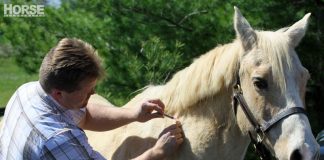Q: I have a coming 3-year-old Quarter Horse gelding that is doing great with training, but I have noticed that he has an underbite. Is there a certain way that I should have the bit fitted? Will he be able to eat normally (grazing and hay)? And would this apply to a horse that has an overbite as well?

Overbite and underbite in horses. Photos by Nancy S. Loving, DVM
To begin, put your horse’s head in a neutral position and check to see if there really is an underbite. The position of the jaws depends in part on the position of your horse’s head. With the head down as with grazing, the lower jaw tends to slide further forward; with the head up (as in a gallop), the upper jaw tends to slide forward.
If your horse relies on pasture grazing, this could be an issue since he needs his incisors to mesh well in order to crop grass effectively. But if you feed hay, he should have no problem acquiring sufficient nutrients from his diet. He can grab hay easily even with incorrectly aligned incisors; chewing is done by the molars in the back of the mouth.
Mismatched incisors could allow for overgrowth of cheek teeth as they continually erupt from the sinuses with age. Overgrown hooks may form on the upper forward cheek teeth and on the rear lower cheek teeth. Routine dental care of these overgrown areas corrects the hooks. In addition, your vet will grind down excessive growth of the mismatched incisors.
While not common with an underbite, a horse with an overbite could develop ulcers of the soft palate if the misaligned teeth dig into the soft tissues of the horse’s palate. Moderate discomfort from resulting sores or ulcers in the mouth can cause a horse to back off his feed. Routine incisor reduction is important to prevent this. Another area to monitor is the temporo-mandibular joint (TMJ), as malocclusion of the incisors can put extra strain on these joints in the jaw.
There should be little problem with bitting in a horse with an overbite or underbite because the bit rests far behind the incisors in a position closer to the upper cheek teeth. Your veterinary dentist can help form a “bit seat” to improve the bit’s position in the mouth. An exception to this could occur if the jawbones are completely misaligned, thereby causing significant bit discomfort. Your veterinarian can advise you about the seriousness of your horse’s dental defect and what procedures might be done to minimize its effects.
NANCY S. LOVING, DVM, is a performance horse veterinarian based in Boulder, Colo., and is the author of All Horse Systems Go.
This article originally appeared in the August 2015 issue of Horse Illustrated magazine. Click here to subscribe!






